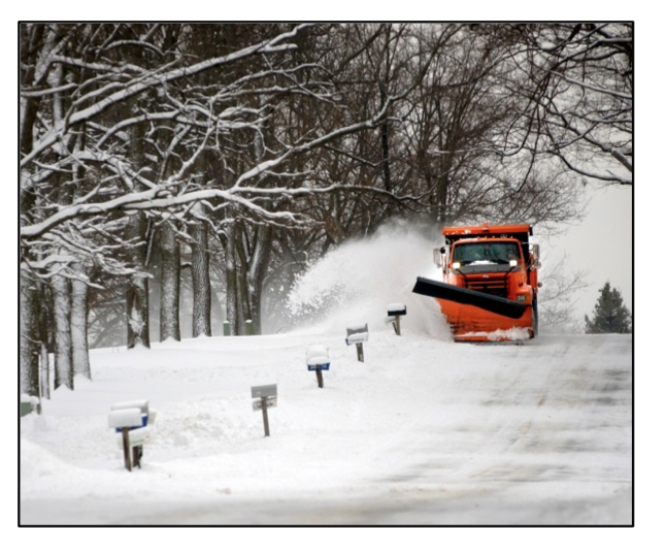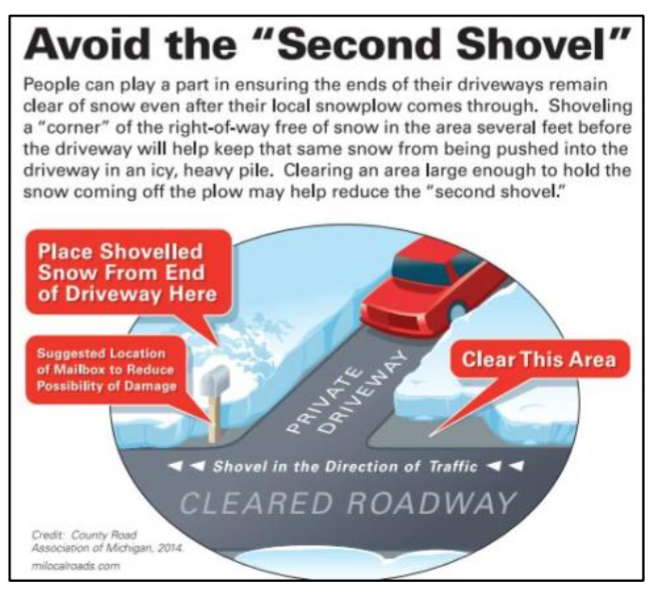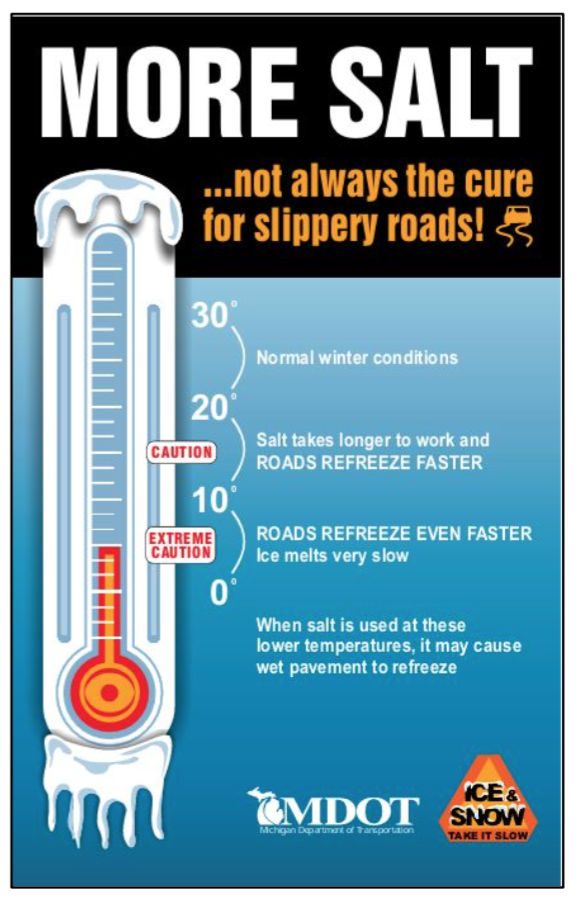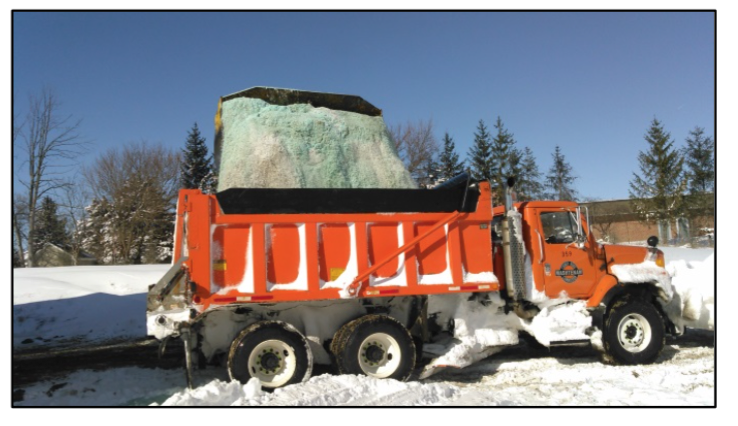Washtenaw County Road Commission Answers Winter Maintenance FAQs
submitted by the Washtenaw County Road Commission
Winter weather will soon be here! With the first several winter events each year come the annual telephone calls. In an effort to answer some of these questions and help the public better understand the issues effecting winter maintenance, the Washtenaw Country Road Commission has created the following list of frequently asked questions.
Why do snowplows block my driveway with snow when they clear the road?
WCRC’s first priority is the safety of the traveling public and clearing the roads of snow and ice by pushing it off the road and shoulders is necessary. Sometimes this means that snow is pushed into driveways. While plow crews try to minimize the amount of snow that gets plowed into driveways during the storm, it is the responsibility of the property owner to clear their driveway opening.
We understand the frustration that this causes area residents. To minimize extra work, we recommend that you shovel to the right side of your driveway as you face the road. Shoveling an area large enough to hold the snow coming off a plow blade may help reduce the need for a “second shovel.”
We cannot pick up the plow blade every time we pass a driveway; it is impractical and our drivers would never finish clearing the roads due to the sheer number of driveways in the county.
My mailbox was knocked down by the snowplow. Who is responsible for replacing it?
The Washtenaw County Road Commission will only replace mailboxes that are damaged by our equipment. We will not replace mailboxes damaged by the sheer force of snow or ice coming off of a plow blade.
Residents should contact the Washtenaw County Road Commission to report mailbox damage resulting from winter maintenance operations. A District Foreman will promptly investigate all mailbox damage claims through our Service Request customer service system. Upon verification by the District Foreman that the mailbox was hit by WCRC equipment, the damaged mailbox and support structure are replaced by district crews, subject to the WCRC policy for erecting mailboxes on county roads.
If the ground is frozen, a temporary mailbox and support structure can be provided until seasonal conditions allow for final installation.
If the property owner elects to make the replacement themselves, a standard type mailbox and support structure can be provided or a cash reimbursement can be provided, processed through the WCRC’s Finance Department. Replacement cost for a standard mailbox and support structure is $60.00.
How can I help prevent mailbox damage during the winter?
Residents should prepare mailboxes for winter by shaking their mailbox. If the mailbox moves when shaken, the mailbox and/or post may not withstand standard snow removal operations and should be repaired or replaced prior to the onset of winter.
Mailboxes are one of the only objects allowed by law to be placed in the road right-of-way. The location and construction of mailboxes must conform to the rules and regulations of the U.S. Postal Service, policies of the Washtenaw County Road Commission and standards established by the American Association of State Highway and Transportation Officials (AASHTO) in “A Guide for Erecting Mailboxes on Highways.”
The post office says that they cannot access my mailbox and won’t deliver my mail.
It is the responsibility of home owners to maintain access for postal mail delivery. Several reasons may prevent snow plow drivers from getting closer to your mailbox including: blocked access due to ice, snow, landscaping or improperly installed mailboxes that come too close to the drivable road surface.
It snowed last night. When will my road be plowed?
When your road will be cleared depends on a number of factors, including the severity of the storm and the type of road you live on. WCRC conducts snow and ice removal based on a priority system. State highways (typically designated by ‘US’, ‘M’, or “I”) and paved county roads have the highest priority, followed by subdivision roads and unpaved gravel or limestone roads.
To learn more about the plowing of gravel and subdivision roads click HERE.
To learn more about the WCRC Winter Maintenance Priorities click HERE.
We pay property tax; why don’t we get better snow removal service?
The property tax you pay is used for your local and county government agencies and for schools, not day-to-day road maintenance. WCRC’s winter maintenance budget is funded solely by the motor fuel tax and vehicle registration fees passed on by the State of Michigan. This income funds all day-to-day maintenance activities included traffic signals, signage, pavement markings, sweeping and both temporary and permanent road and bridge repairs.
In late 2015, the Michigan State House and Senate approved a road funding package, which was signed into law by Gov. Snyder on November 10, 2015, that would increase the gas tax and vehicle registration fees, but these changes do not begin to go into effect until January 1st, 2017.
The portion of your property tax bill that is part of the P.A. 283 road millage may only be used for specific, pre-determined road construction projects. Individual townships may levy funds from local road millages or dedicate general fund revenue for specific local road improvement projects and seasonal dust control for gravel roads.
Why do bridges and overpasses freeze before the surface of the road?
While temperatures on the road surface drop, the heat underneath the road keeps it warm enough to prevent icing as temperatures drop below freezing.
Bridges have no way to trap heat, so they continually lose heat and freeze shortly after temperatures hit the freezing point. If the air temperature falls below freezing, a bridge's surface will likely be freezing too, causing rain and snow to freeze and stick to the road surface.
Why can’t salt be put on roads and bridges before it snows?
Putting salt on road surfaces prior to a snowfall is a waste of time and money since salt often bounces off the dry road during application. The portion that manages to land and stay on the road surface is subject to wind and will likely blow off the road before it can do its job.
Salt is most effective after snow has accumulated and the temperature is 20° F or higher. Under these conditions, the salt and snow will mix, melting snow into slush that can be plowed off the pavement. This melting action will occur within two hours, less if traffic is using the highway.
If the temperature is below 20° F, the salt will have difficulty melting the snow and ice, so other methods are used. Abrasives are often put down for traction. Salt brine can be added to enhance the ability to melt the ice and snow. The road commission may change the mixture of salt and additives based on the ground temperature.
What is the importance of pavement and ground temperatures? Why not rely on just air temperature?
The ability of a de-icing agent to melt snow and ice depends on the temperature of the roadway and not the air temperature. During the fall season, the pavement is often warmer than the surrounding air because of the warm soil. During the spring, the reverse may be true. The pavement temperatures can be colder than the air because the soil is still frozen from the low winter temperatures. The sun also has a strong influence on the pavement temperatures. The sun can help heat the pavement and speed the melting process. Air and pavement temperatures can differ by as much as 20 degrees Fahrenheit.
Is it legal to pass a snowplow?
There are no state laws that prohibit passing a snow plow, but passing a snow plow can be extremely dangerous. The Washtenaw County Road Commission recommends keeping a safe distance.
Snowplows may be equipped with wing plow blades that can extend anywhere between 2-10 feet beyond the width of the truck. This wing plow blade is often not seen because of the snow cloud being kicked up by the snowplow. These wing plows can often weigh as much as a compact car.
I’ve seen snowplows driving along during a storm with their plows raised. Why aren’t they plowing?
There are a couple of reasons plows aren't always pushing snow:
- Plows may be in operation only to spread materials, or may be out of materials to spread and headed back to the garage to reload.
- The road may have been treated with salt or de-icing products and plowing it may remove the mixture before it has an opportunity to work.
- The driver does not have the responsibility for the road he/she is currently on and is heading elsewhere. Plow routes are designed to minimize travel in between service areas.
The snowplow was speeding past my house.
WCRC drivers are required to follow all applicable laws and are held responsible for violations. Please contact WCRC with the time and location for us to follow up. Please be aware that snow plow trucks are often in a low gear and using a high engine RPM to maintain the power necessary to push the snow and that this creates the impression that they are speeding. Additionally, the truck size, engine, size of the plow blades and flying debris can make it appear that a plow truck is moving faster than it actually is.
Why do workers spray liquid onto the roadways before a big storm arrives?
It may seem dangerous to add liquid to a road that might freeze, but the liquid is most likely salt brine which will prevent snow from sticking to the road or bridge deck and prevent frost or black ice.
Why would salt be spread on a bare highway after a snowstorm is over?
The projected temperature of the road surface will impact the final treatment of a road. If plowing operations have finished and a road is left in “black and wet” condition, there is sometimes a danger of the water on the road re-freezing. There are times, especially at night, when this post-storm salt application may be necessary.
I have a medical condition. Can you plow my street in case there is an emergency and an ambulance needs to get though?
The Washtenaw County Road Commission works in close coordination with emergency services during snow events and clears roads based on a priority system. We clear paved roads and highways first followed by subdivision roads. If paved roads and highways are not clear, emergency vehicles will not be able to reach subdivision roads.
The potential for a medical emergency does not warrant priority treatment. Anyone needing an ambulance in a medical emergency should contact 911 where all necessary steps will be coordinated.
I live on a cul-de-sac and I get more snow in my driveway and on my property than anywhere else. Why?
Plowing cul-de-sacs is one of the more challenging operations after a snow storm. Most properties on a cul-de-sac have frontages which are narrower than lots of straight streets. Therefore, snow must be pushed into a smaller space. Cul-de-sacs without islands contain even more area which needs to be plowed and, as a result, even more snow has to be moved to the side.
Can the snowplow operator plow my driveway or berm if I am elderly, disabled or not physically able to shovel?
Unfortunately, the Washtenaw County Road Commission does not have the resources to plow the driveways and/or berms of those who are unable to do so. Our primary goal is to use the resources we have to provide safe and reliable roadways in the most efficient manner possible. We encourage those who are not able to shovel to ask neighbors for assistance or hire a private snow plow service.














You must be logged in to post a comment Login